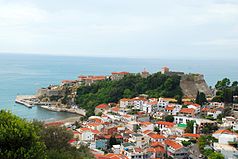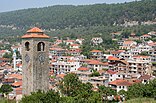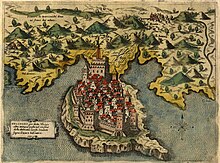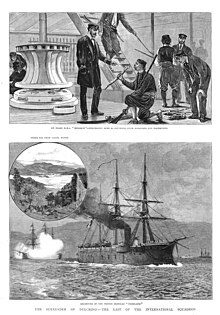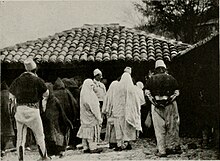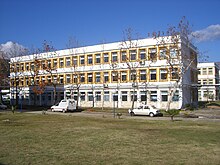
Montenegro is a country in Southeast Europe, located in the Balkans. It is bordered by Bosnia and Herzegovina to the north, Serbia to the northeast, Kosovo to the east, Albania to the southeast, and Croatia and the Adriatic Sea to the northwest with a coastline of 293.5 km. Podgorica is the country's capital and its largest city; it covers 10.4% of Montenegro's territory of 13,812 square kilometres (5,333 sq mi), and is home to roughly 31% of its total population of 621,000. Cetinje is the former royal capital and cultural centre of Montenegro and is the location of several national institutions, including the official residence of the President of Montenegro.
The early written records of the history of Montenegro begin with Illyria and its various kingdoms until the Roman Republic incorporated the region into the province of Illyricum after the Illyro-Roman Wars.

Bar is a town and seaport in Coastal region of Montenegro. It is the capital of the Bar Municipality and a center for tourism. According to the 2023 census, the city proper had 15,868 inhabitants, while the total population of Bar Municipality was 46,171.

Budva is a town in Coastal region of Montenegro. It has 19,218 inhabitants, and it is the centre of Budva Municipality. The coastal area around Budva, called the Budva Riviera, is the center of Montenegrin tourism, known for its well-preserved medieval walled city, sandy beaches and diverse nightlife. Budva is 2,500 years old, which makes it one of the oldest settlements on the Adriatic coast.

Medun is a settlement located 13 km northeast of the capital Podgorica, Montenegro. The village houses the archaeological site of the ancient fortified city of Medeon. It is situated in the tribal area of Upper Kuči, one of the highland tribes. In the 2003 census, it had 108 inhabitants. In ancient times, Medun was inhabited by the Illyrians between the 4th and 3rd centuries BC.
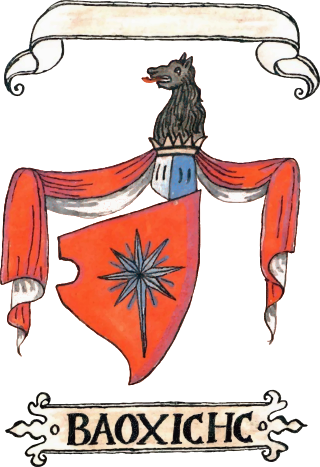
Đurađ II Balšić, or Gjergj Balsha IIfl. 1385 – April 1403), was the Lord of Zeta from 1385 to 1403, as a member of the Balšić noble family. He was the son of Stracimir Balšić, and succeeded his paternal uncle Balša II in ruling Zeta. He reigned from 1386 up to 1389 in the still officially undissolved Serbian Empire in the form of a family alliance, then up to 1395 as an Ottoman vassal. He ruled until his death in 1403, when he was succeeded by his only son, Balša III. He is known in Serbian epic poetry as Strahinja Banović.
The Montenegrin Littoral, historically known as the Littoral or the Maritime, is the littoral or coastline region of Montenegro which borders the Adriatic Sea. The littoral was lost to Austria and Turkey during its collapse due to Ottoman invasion - but it was regained in 1878 and 1918 following the Serbian-Montenegrin victories in the Russo-Turkish War and World War 1 respectively.

Ulcinj Municipality is the southernmost municipality of Montenegro, bordered by Albania to the east, Bar Municipality to the north and Adriatic Sea to the south and the west. It has an area of 255 km², and a population of 19,921 as of the 2011 census. Its seat is the town of Ulcinj.
Albanians in Montenegro are an ethnic group in Montenegro of Albanian descent, which constitute 4.91% of Montenegro's total population. They are the largest non-Slavic ethnic group in Montenegro.

The Buna river, also known as Bojana, is a 41-kilometre-long (25 mi) river in Albania and Montenegro which flows into the Adriatic Sea. An outflow of Lake Skadar measured from the source of the lake's longest tributary, the Morača, the Morača-Shkodra Lake-Bojana system is 183 km (114 mi) long.

Ada Bojana is an island in the Ulcinj Municipality in Montenegro. The name Ada means river island in Montenegrin.
Montenegro is one of the fastest-growing tourist destinations. In 2007, over a million tourists visited Montenegro, making some 7.3 million overnight stays. This accounted for some 480 million euros in tourism revenue in 2007. In 2015, tourism realised over 1.7 million arrivals, with a further increase in 2016. In the same year, the coastal town of Kotor was named the best city to visit by Lonely Planet, whereas the country itself is continuously included in touristic top lists. With a total of 1.8 million visitors in 2016, the nation became the 36th most popular country to travel to in Europe. Montenegro was further visited by over 2 million tourists in 2017. The Government aims to attract greenfield investments, which should make best use of undeveloped parts of the coast, such as Jaz Beach, Velika Plaža, Ada Bojana and Buljarica.
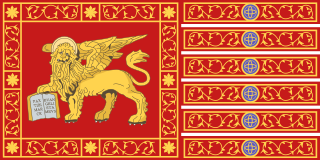
Venetian Albania was the official term for several possessions of the Republic of Venice in the southeastern Adriatic, encompassing coastal territories primarily in present-day southern Montenegro and partially in northern Albania.

Zeta was one of the medieval polities that existed between 1356 and 1421, whose territory encompassed parts of present-day Montenegro and northern Albania, ruled by the Balšić family from 1356.

The Sailors' Mosque is an important landmark in Ulcinj, Montenegro that once served as a lighthouse.

Ulcinj Old Town or Ulcinj Castle is an ancient castle and neighborhood in Ulcinj, Montenegro. Today mostly inhabited by Albanians, it was built by the Illyrians on a small peninsula at the right side of the Pristan Gulf, which is part of the Adriatic Sea. Today, oldest remains are the Cyclopean Wall. The castle has been restored many times since it was first built although major changes were made by the Byzantinians, Serbs, Venetians, and Ottomans. The modern city of Ulcinj was built outside of this castle.

Battle of Ulcinj took place between the Ottoman forces of Dervish Pasha and Albanian irregulars in the year of 1880 at the region of Kodra e Kuqe, close to Kllezna. The area of Plav and Gusinje had been ceded to Montenegro according to the Treaty of Berlin (1878), but the Albanians fought against the annexation. The Great Powers then persuaded the Ottomans to cede the area of Ulcinj, but the Albanians yet again refused. Eventually, the Great Powers commanded the Ottomans to take actions against the League of Prizren, ending the resistance and successfully handing over the town of Ulcinj to Montenegro.

Shkodër is the fifth-most-populous city of the Republic of Albania and the seat of Shkodër County and Shkodër Municipality. Shkodra has been continuously inhabited since the Early Bronze Age, and it has roughly 2,200 years of recorded history. The city sprawls across the Plain of Mbishkodra between the southern part of Lake Skadar and the foothills of the Albanian Alps on the banks of Buna, Drin and Kir. Due to its proximity to the Adriatic Sea, Shkodër is affected by a seasonal Mediterranean climate with continental influences.

A period of Albanian piracy occurred from the 15th to the 19th centuries, during which Albanian pirates plundered and raided ships. These pirates were based mainly in Ulcinj, but were also found in Bar and Ragusa, and had connections with North Africa.

Coastal Montenegro, is one of three statistical regions in Montenegro. It encompasses the coastal part of Montenegro. It is bordered by Central region to the north, Albania to the east, Adriatic Sea to the south, Croatia to the west, and Bosnia and Herzegovina to the northwest. It comprises six municipalities.
